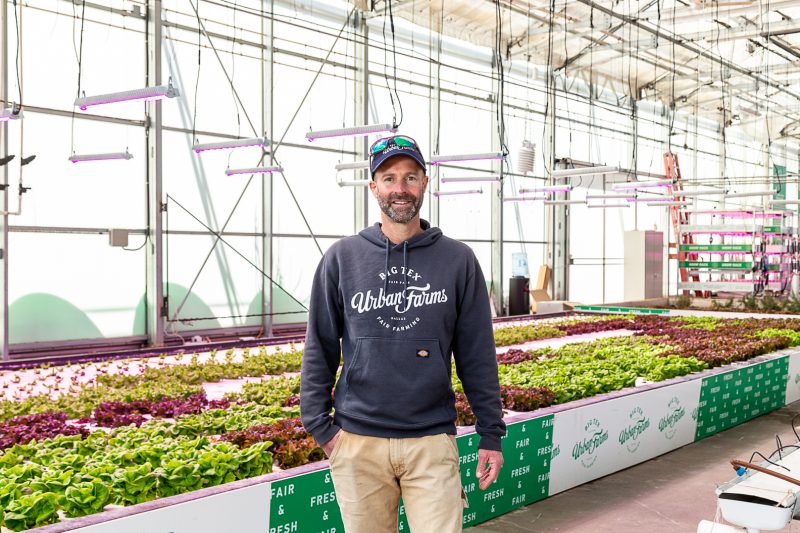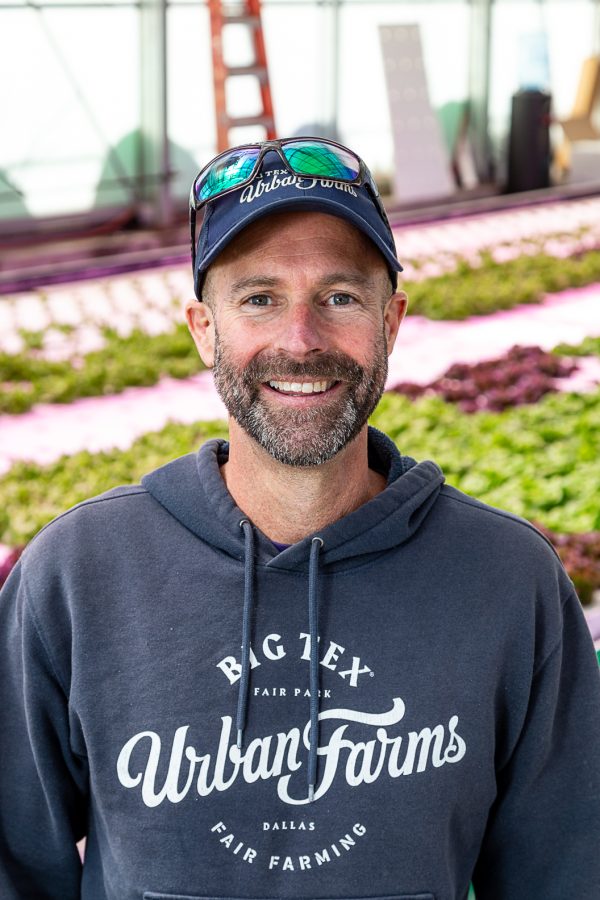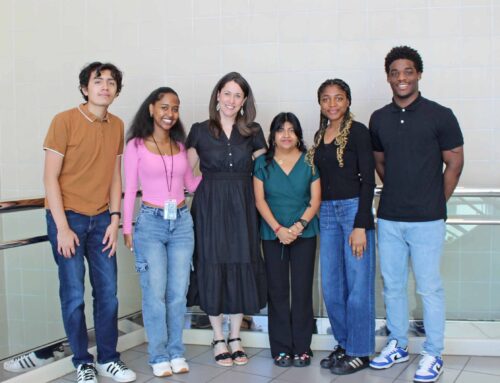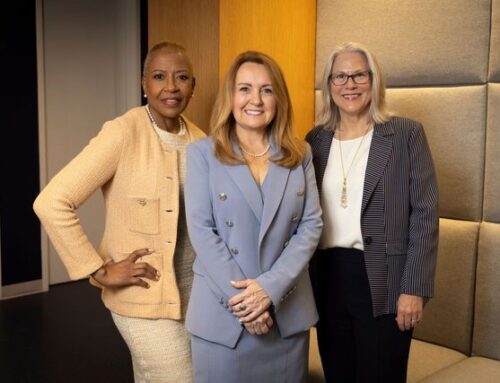
Photography by Yuvie Styles.
He’s a greenery guru, the sultan of soil, a horticultural hero — you get the idea.
White Rock area resident Drew Demler serves as head grower for Big Tex Urban Farms — headquartered inside the translucent Errol McCoy Greenhouse at the base of the famous Ferris wheel on the grounds of Fair Park — a job that keeps him in the weeds year round.
Lest you assume a garden guy might be a wallflower, rather than a people person, know this: The man is no shrinking violet. He’s a highly effective emissary of the State Fair of Texas and all-around ambassador for urban agriculture.
When TV news crews show up, Demler guides the tour — charismatic, instructive, beaming for the camera in a pink-purple grow-light glow, bragging on shiny bell peppers and bok choy plants with leaves as big as Tex’s boot.
He produces YouTube videos on the wonders of microgreens and nanobubbles or tree grafting, speaks at symposiums, teaches agriculture to college students and instructs vegan cooking classes. He is not a judgy vegan; he’s the type who sometimes thinks about eating eggs.
His love of farming goes beyond growing beautiful, fragrant fields. Demler has helped revolutionize the State Fair’s program, transforming an essentially ornamental endeavor into an outreach that helps feed thousands of Dallas families every year. With a network of partners and State Fair resources, he helped install a hydroponic growing system that in 2020 yielded 26,000 pounds, or 295,000 servings, of produce. Today, 100% of the Big Tex Farm harvest goes to the community. And when Demler is not on the Midway, he’s often in nearby neighborhoods teaching and helping others.
That’s why he’s the maharishi of mulch, the vegetation virtuoso, a svenghali of shrub.
When did you know plants were going to be your thing?
I started out around plants at a very young age, working at a garden center in Baton Rouge, where I am from. As a kid I was real active, always on the move, it was the thing that held my attention. Early 20s, I took a job in Austin, at the city’s largest independent garden center at the time, and I quickly became manager. With that momentum, I had my own place for a while, Seasons Garden Center in Leander, but there were some forces working against us, so it only lasted about six years. Even though it didn’t work out, I accumulated tons of experience.
Maybe you were needed somewhere else, like …
I got a job as one of the head horticulturalists at the Dallas Arboretum — that got me to Dallas. I enjoyed my time at the Dallas Arboretum. Obviously, it’s such a beautiful place, but I had not been there long, maybe six months, when this position at the State Fair, greenhouse manager, opened up. It just sounded so unique to me — you have this greenhouse, growing ornamental plants right next to this giant Ferris wheel. I thought, I just have got to try that.
WERE YOU PREPARED FOR THE BIGNESS OF THE STATE FAIR?
This was another level. For the first five years, my job was ornamental horticulture. I grew things like bougainvilleas and palm trees and varieties of hanging baskets and tropicals, and we still do, but we’ve scaled some of those things down to make way for farming. On April 1, 2016, we planted our first seeds for the Big Tex Urban Farms.
The pretty plants and the food-producing plants — is there an opportunity for those things to mingle?
They can intermingle more than people think. There’s no reason we shouldn’t be planting things like okra in our flower beds. It’s a hibiscus relative and makes a gorgeous yellow flower. Different types of peppers — I’ve seen people make a hedge out of them. They look glorious. There’s no reason in your vegetable garden you shouldn’t have some marigolds and pintas … maybe some coneflowers or native varieties that are going to attract bees and butterflies and good pollinator insects. If you go back a generation, people who were into gardening did a lot more marrying of ornamentals and edibles. There might be a couple of rows of cut flowers to bring in the house and put in the vase.
What does your garden at home look like?
I am kind of just getting started in a new place. I’ve planted potatoes and onions. It’s been a slow start because the weather’s been so funky, but the onions are starting to root really good and starting to stand up nice and straight, potatoes are sprouting, it’s happening. On the backside of the last cold spell, I’m going to start my green beans …
So springtime, that’s a good time for planting?
April is rock ‘n’ roll. It’s tomatoes. It’s peppers. It’s your green beans. If you’re gonna get any greens going, you need to plant them as soon as you can, like kale and collard, get some roots going before the heat sets in. By late April, it’s going to be time for melons, squash and cucumbers. All the warm-weather favorites.
Texas has brutal summers and winters. How hard is our climate on growers?
It has to be one of the most challenging climates, no doubt about it. Especially because it can be so inconsistent. Tips and tricks can help. If you don’t have a greenhouse or hoop house, you can still set up PVC and make a tunnel out of them. You can put frost blankets over the top of your sensitive crops on the cold days. You can use shade cloth in the summertime. Cheating every chance you get helps your odds.
What’s your favorite vegetable to eat and grow? It can be different things.
If you pinned me down, I would say the black-eyed peas, a nice warm pot on a cold day. Cornbread on the side. But growing, watching melons is a really neat process. It starts the size of a thumbnail or smaller and you see them swell up sometimes over night. And my children love the watermelon, so they get excited.

How many kids, where are they, and how about the wife — does she like this stuff?
Three boys, two at Lake Highlands Junior High, another at the magnet school in Richardson. And Carol, my wife, is not into it. She is a fitness specialist and works for the YMCA.
How about those giant watermelons we see in grocery stores — that’s not natural is it?
What it is, is some really smart farmers — master geneticists able to recognize in their fields which melons stand out in size, and they will save seed from those and they’ll continue to plant them and sometimes cross pollinate with other melons that are also growing large. They’ve worked on some of those varieties for centuries now.
I know a lot of people who started gardening or going nuts with the house plants during pandemic lockdowns. Why did that happen, do you think?
Maybe because people were at home, looking for something to do. Maybe, hopefully, that stuck. I think it’s going to become more important for people to be able to produce their own food, for environmental reasons. Again, if we go back to generations past, it was a much bigger deal to use people’s gardens as a food source. And we’re capable of doing a lot more than we think we are, even in small spaces. At the very beginning of quarantine, I posted a video about how easy it is to home-grow microgreens.
Are there people who, for the sake of the plants, should not own plants? Like if you have a really hard time keeping them alive?
Anyone can do this. Not everyone is a natural. It’s largely a hobby consisting of persistence. You’ve got to be able to take it on the chin and know that’s going to happen sometime and just be ready to plant that next seed again. If you’re willing to do that several times over you’ll end up having success.
For Drew’s videos on microgreens, community gardens and more, visit BigTex.com or search Big Tex, Drew Demler on YouTube.
Interview edited for brevity.





